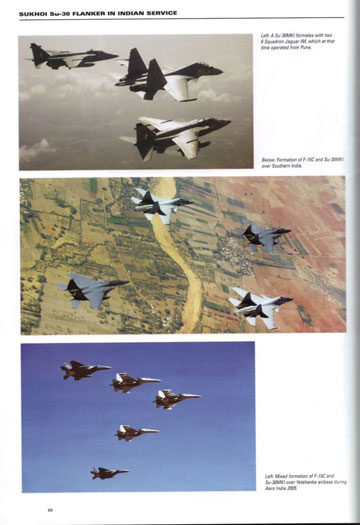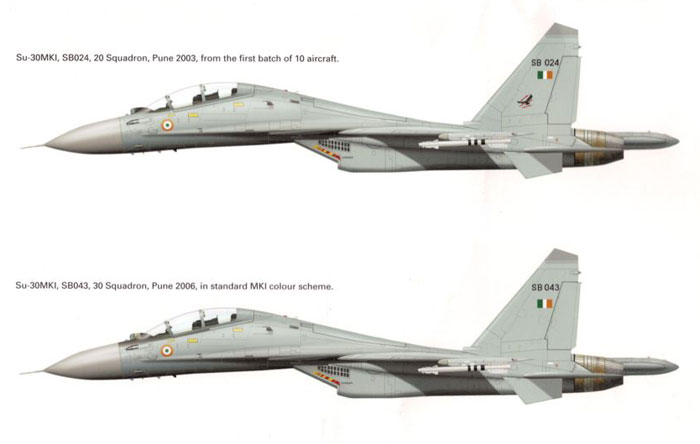|
S u m m a r y |
Title and Author: |
Sukhoi Su-30 Flanker in Indian Service
by Phillip Camp with Simon Watson
Aviation Bookshop Publishing |
Media: |
Softcover, 96 pages |
ISBN: |
9780955959707 |
Price: |
MSRP: GBP 16.99 available online from the Aviation Bookshop |
Review Type: |
First Read |
Advantages: |
Great photo coverage of what is probably the ultimate Flanker. Nice extras including colour profiles |
Disadvantages: |
Hard to fault |
Conclusion: |
Taking advantage of the willingness of the Indian Air Force to despatch this aircraft to exercises around the world, this book is both an enthusiasts and modellers delight. |
Reviewed by Ken Bowes

HyperScale is proudly supported by Squadron
The Su-30MKI Flanker is the result of a torturous development process dating back to the mid-1990s. At that time renewed relations between Russia and India, combined with the existence of a number of Su-27PU dual seat Flankers which the Russian Air Force could not afford led to the Indian Air Force evaluating and subsequently ordering the Flanker as a new multi-role fighter. Whilst these Su-27PUs ultimately became the first IAF Su-30Ks, they also represented the first stage of a defined development path that will eventually result in significant numbers of the advanced Su-30MKI entering Indian Air Force service.
 The Su-30MKI incorporates many new design aspects that separate it from other Flanker variants including the BARS passive ESA radar, indigenous avionics, canard foreplanes and thrust vectoring engines. The Su-30MKI incorporates many new design aspects that separate it from other Flanker variants including the BARS passive ESA radar, indigenous avionics, canard foreplanes and thrust vectoring engines.
Whilst development of the MKI variant continues, the Indian Air Force has entered an ambitious program of overseas engagement, exposing their aircrew to advanced aircraft and tactics that combine to build the skill and professionalism of the IAF. The western fighter community has long regard the Indian Air Force as a formidable force, operating the best Russian equipment with a western mind-set. As a result Western Air Forces have been quick to invite Indian units to bi-lateral and combined exercises. Amongst these deployments have been participation in the US led Red Flag and the Indradhanush series with the Royal Air Force. It is as a result of this regular overseas presence combined with visits to the Flanker bases that Phillip Camp and Simon Watson have been able to produce this excellent book on the Indian Flanker.
Whilst primarily a photographic volume, the authors provide all the necessary background as to how India came to be a Flanker operator. There follows sections covering the initial use of the Su-30Ks of the interim batch, the development and service entry of the Su-30MKI and the details of local production phases as the technology in the aircraft matures. Other areas covered include the service history to date and participation in the exercises mentioned earlier, weapons loadouts and Squadron histories. For the modeller there is also a detailed section on colour schemes that will be of use, notwithstanding the difficult conversion required to produce an S-30MKI model from existing Su-27UB kits.
As with other books of this genre, the last of the book is a comprehensive photo walkaround of the Su-30K and Su-30MKI airframe and many of the associated weapons employed by the IAF including AA-10, 11 and 12 air to air missiles, Kh-31 air to surface missile and dumb bombs. This is provides a detailed look at the airframe and will be of immense help if a conversion is attempted or a much longed for model of this interesting aircraft. Overall this book provides very good coverage of the Su-30K and MKI as they are now and it should be of interest and value to those with an interest in modern aviation. I showed this book to a colleague of mine who happens to be an IAF MiG-29 pilot and he was of the opinion that it was fantastic. I am inclined to agree.

Thanks to Simon from Aviation Bookshop for the sample
Review Copyright © 2008 by
Ken Bowes
This Page Created on 26 November, 2008
Last updated 26 November, 2008
Back to
HyperScale Main Page
Back to
Reviews Page |
